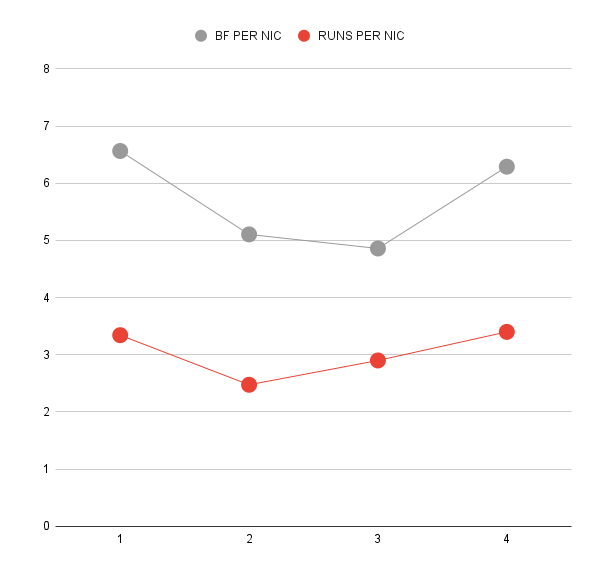The records published by CricViz’s Srinivas Vijaykumar show that the South African pace attack in the recently completed series against India had a release point 17 cm higher than that of the Indian bowlers on average. On wickets where there was more lateral movement off the pitch early in the match, and more uneven bounce as the match progressed, this had a peculiar effect.


The control figures recorded by ESPNCricinfo (thanks to friends at Cricinfo for sharing this data) show a revealing pattern. In all three Tests, India batted first and bowled fourth. These have been charted below, summarized for the series.
Consider the gray measurement first. This gives the frequency of false shots by match innings. For the first three innings, as the pitch wears, the frequency of false shots rising. In the fourth innings there is a reversal. The Indian bowlers were unable to create as much jeopardy for the South African batters in the 4th innings compared to the 2nd innings.
Tests tend to speed up as the pitch wears. India scored at 3.6 runs per over in the 3rd innings compared to 3.1 runs per over in the first. In the 4th innings, India’s bowlers were less effective than they were in the 2nd.
Would a fit Ishant Sharma have made a difference for India? Perhaps. But as brilliant as Mohammed Shami and Jasprit Bumrah were in the series, their effectiveness was markedly different in both innings. In the 1st innings they managed 17/242 between them, conceding for 2.3 runs an over. In the 2nd innings, they managed 9/333, conceding 3.3 an over. Shardul Thakur was similarly more effective in the 1st innings compared to the second.
By contrast, the South Africa trio of Rabada, Ngidi and Jansen managed 25/494 in the 1st innings (conceding 2.9 an over) and 29/425 in the 2nd (conceding 3.1 an over). They were able to extract the same returns from the conditions in both innings.
This is one of the reasons why its worth being cautious when blaming the Indian batting (a popular pastime). Either the South Africans were clueless against Indian bowlers in the 1st innings and magically recovered their touch in the 2nd, or the South African bowlers, with their extra height, extracted more misbehaviour from the pitch in the 2nd innings than the Indian bowlers could.
Is this a shortcoming on the part of the Indian bowlers? I’d say not. Its a difference of kind rather than quality. India couldn’t make up that 17 cm. disadvantage and match the extra variation in bounce the South Africans could extract.
These are two evenly matched sides and if they played a 11 Test series, it would probably still end 6-5 either way. This should have been a five Test series. It would have been an epic. As it was, it will go down as a mini-classic.





Do you see any validity to my earlier points? Or am I missing something?
These are excellent points about SA bowler's point of release etc..That is half the battle..the other half is the batsman's technique..The batting does get easier when the ball got old..so middle and lower order were there at this point to play properly..rather expansive drives resulted in getting themselves out..